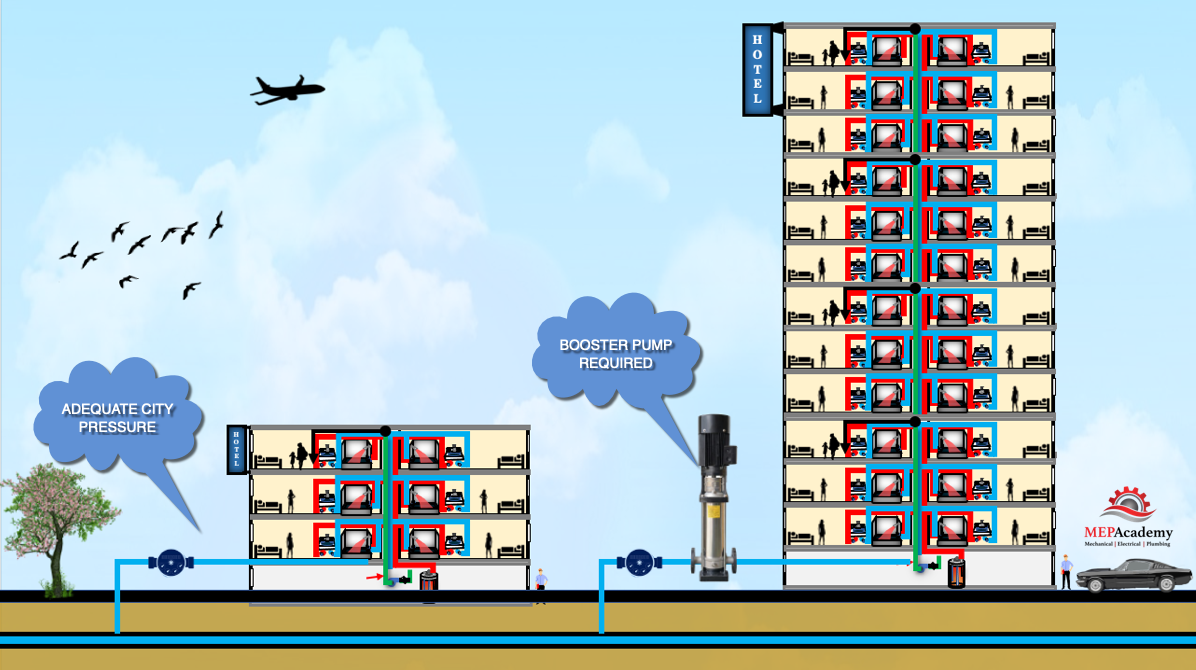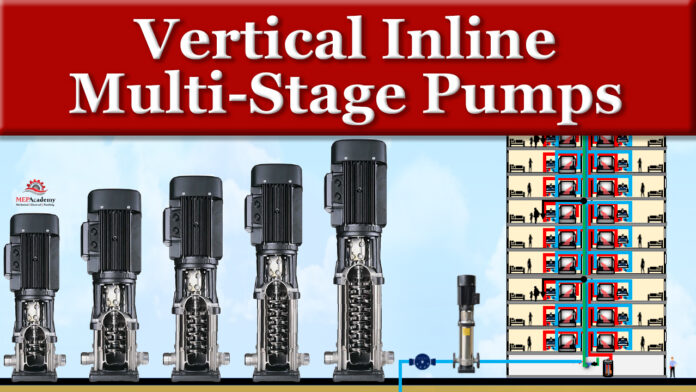Vertical Inline Multi-Stage Pumps. In this article we’ll cover Vertical inline multi-stage pumps that are used to boost domestic water supply pressure in multi-story buildings when city pressure is insufficient.
If you prefer to watch the Video of this presentation, then scroll to the bottom or click on this link. Vertical Inline Multi-stage Pumps.
For plumbing fixtures to work correctly and provide the necessary flow of water, there must be a minimum amount of pressure for proper operation. If the city water supply doesn’t have enough pressure to overcome all the pressure losses in the system and provide the minimum operating pressure for the plumbing fixture, then one of the strategies is to add a booster pump.
The booster pump can extend the supply water pressure to reach plumbing fixtures on the upper floors of a high-rise building, when the water companies supply pressure is insufficient. With a multi-stage pump, multiple impellers are used to increase the pressure. See our other video on How to size Water Supply Piping using Fixture Units.

In our previous discussion on how to size water piping we used a 4-story building that didn’t require a booster pump, because the city pressure was adequate enough to overcome all the pressure drops and provide the minimum required pressure at the most remote demanding plumbing fixture. Here, we take that same building, and add another 9 floors, for a total of a 13 story building. A quick look at our previous calculation will quickly inform us, that there isn’t enough city pressure to get the water to the top floor plumbing fixtures. This will require a booster pump.
Single Stage vs Multistage Pumps
Single stage pumps use only one impellor which are best applied in large flow, low pressure applications. Multi-stage pumps provide a varying rate of water flow and pressure conditions that provide better energy savings in the right application. With a multistage pump there are two or more impellers stacked in series.

Vertical multi-stage pumps are designed with multiple impellers mounted on a common shaft. Each impeller consists of curved blades that accelerate the fluid and increase its pressure. The number of impellers can vary depending on the desired pressure requirements. The impellers are installed in series, one after the other on a single shaft that is powered by a motor that sits on top.
These charts show that for any given size pump, if the number of impellers is increased, the pressure available also increases. Also, note as flow decreases, more pressure becomes available with the same number of impellors, or said another way. As flow increases the available pressure decreases. That’s why it’s important to select a pump that can handle the maximum flow at the required pressure.
How do Vertical Inline Multistage Pumps Work
Domestic supply water enters the suction side of the pump and into the first impeller which feeds the next impellor in series in multistage or multi-impeller pumps. Each impellor feeds the next one, which could include dozens of impellers stacked vertically on top each other. Each impellor raises the pressure further without effecting the water volume. The volume will be increased as demand increases by increasing the speed of the motor using a variable speed drive. See our video on How Variable Speed Drives work.
By engaging multiple stages of impellers, the pressure can be increased or decreased, while the volume of water can be increased or decreased by controlling the speed or RPM of the motor with a VFD. By increasing the number of pump impellers in series, greater pressures can be achieved, with each successive impeller increasing the pressure above the previous impeller.
As the impeller rotates, it creates centrifugal force, which pushes the liquid outwards and towards the edge of the impeller blades. This force creates a low-pressure area at the center of the impeller, which causes more liquid to flow into the pump from the inlet. The liquid is then forced out of the pump through the discharge port and into the system where it is needed.
Vertical pumps can be used in a variety of applications, such as in HVAC systems, water supply systems, and industrial processes. They are known for their reliability, efficiency, and ease of maintenance.
Multi-pump Controller
When multiple pumps are used, a controller can regulate the quantity of pumps that operate and efficiently allocate their runtime by alternating lead and lag pumps for even wear. The pump curves can be programmed into the controller to optimize their most efficient operating points. Having VFD’s maintain a constant pressure ensures that various water demands are provided with sufficient pressure while reducing motor speed when demand falls off. This will reduce pump wear, maintenance cost, energy cost, and extend the life of the pumps.
Design: Vertical pumps consist of several key components. The main parts include the motor, impeller, volute casing, and shaft. The motor provides the rotational power, while the impeller is a rotating component with curved blades that accelerates the fluid.
Suction: The pump is installed vertically, with the inlet and outlet located at the bottom. The fluid enters the pump through the suction inlet.
Centrifugal force: As the impeller rotates, it imparts centrifugal force to the fluid. The curved blades of the impeller push the fluid outward, creating a high-velocity flow.
Conversion of kinetic energy to pressure energy: As the fluid leaves the impeller, it enters the volute casing, which is a spiral-shaped chamber surrounding the impeller. The volute casing gradually expands in diameter, allowing the high-velocity fluid to slow down and convert its kinetic energy into pressure energy.
Discharge: The fluid exits the pump through the outlet located at the bottom. It is then directed to the desired destination, such as a pipeline or a storage tank.
Control: Vertical pumps often incorporate various control mechanisms to regulate the pump’s operation. These may include sensors, pressure switches, and variable frequency drives (VFDs). These controls help maintain optimal performance, prevent overload, and enable energy-efficient operation.
It’s important to note that the specific design and functionality of vertical pumps can vary depending on the model and application. Therefore, it’s advisable to refer to the manufacturer’s documentation or consult an expert for detailed information on a particular pump model or system.
These pumps are energy efficient, reliable, and quite when operating. Vertical inline multi-stage pumps work by utilizing a motor that drives a shaft with an impeller attached to the end. The impeller rotates, creating a flow of liquid through the pump. The liquid enters the pump through the inlet and is directed towards the impeller.
To calculate losses during the sizing process of a water booster pump, it’s important to measure static height or lift to determine the static losses, while calculating dynamic losses as well. Static height equals the elevation measured from the booster pump to the highest point of the water in the building, while dynamic losses depend on the water consumption. When water consumption or flow is high, dynamic losses in pipes and fittings will increase. When there is no water flow, there are no dynamic losses.
Variable Speed Drive (VFD)
Variable Speed Drive (VFD) pumps can adjust the flow and pressure to the variations in water demand. Constant rate pumps don’t have the required operating ability to adjust the flow rate or speed to meet varying demands of the water supply. If used in a hotel where there may be no flow one minute then a large demand as guest awake to take their morning showers, the need for variable speed provides the responsiveness required to meet this varying demand by speeding up or staging more pumps.






